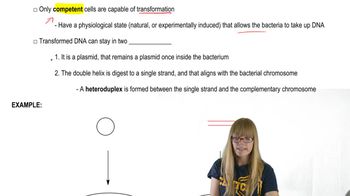Which of the following mutagens wedges between DNA bases to disrupt the helix structure?
Table of contents
- 1. Introduction to Genetics51m
- 2. Mendel's Laws of Inheritance3h 37m
- 3. Extensions to Mendelian Inheritance2h 41m
- 4. Genetic Mapping and Linkage2h 28m
- 5. Genetics of Bacteria and Viruses1h 21m
- 6. Chromosomal Variation1h 48m
- 7. DNA and Chromosome Structure56m
- 8. DNA Replication1h 10m
- 9. Mitosis and Meiosis1h 34m
- 10. Transcription1h 0m
- 11. Translation58m
- 12. Gene Regulation in Prokaryotes1h 19m
- 13. Gene Regulation in Eukaryotes44m
- 14. Genetic Control of Development44m
- 15. Genomes and Genomics1h 50m
- 16. Transposable Elements47m
- 17. Mutation, Repair, and Recombination1h 6m
- 18. Molecular Genetic Tools19m
- 19. Cancer Genetics29m
- 20. Quantitative Genetics1h 26m
- 21. Population Genetics50m
- 22. Evolutionary Genetics29m
17. Mutation, Repair, and Recombination
Induced Mutations
Problem 1b
Textbook Question
How do we know that certain chemicals and wavelengths of radiation induce mutations in DNA?
 Verified step by step guidance
Verified step by step guidance1
Understand that certain chemicals and wavelengths of radiation are mutagens, which are agents that cause changes in the DNA sequence. These changes can be studied experimentally to determine their effects on DNA.
Design an experiment where cells or organisms are exposed to a specific chemical or type of radiation. Include a control group that is not exposed to the mutagen to compare results.
Use molecular techniques, such as DNA sequencing, to analyze the DNA of the exposed group and the control group. Look for differences in the DNA sequence that indicate mutations.
Correlate the frequency and types of mutations observed with the exposure to the chemical or radiation. For example, ultraviolet (UV) radiation is known to cause thymine dimers, which are specific DNA lesions.
Confirm the results by repeating the experiment and using different concentrations of the chemical or varying the intensity/duration of radiation exposure. This helps establish a dose-response relationship, further supporting the conclusion that the agent induces mutations.
 Verified video answer for a similar problem:
Verified video answer for a similar problem:This video solution was recommended by our tutors as helpful for the problem above
Video duration:
2mPlay a video:
Was this helpful?
Key Concepts
Here are the essential concepts you must grasp in order to answer the question correctly.
Mutagenesis
Mutagenesis refers to the process by which genetic mutations are induced in an organism's DNA. Certain chemicals, known as mutagens, can alter the structure of DNA, leading to errors during replication. Similarly, specific wavelengths of radiation, such as ultraviolet (UV) light and ionizing radiation, can cause direct damage to DNA, resulting in mutations. Understanding mutagenesis is crucial for studying how environmental factors can influence genetic stability.
Recommended video:
Guided course

Induced Mutations
DNA Repair Mechanisms
Cells possess various DNA repair mechanisms that correct damage caused by mutagens. These include base excision repair, nucleotide excision repair, and double-strand break repair. Each mechanism is tailored to address specific types of DNA damage, ensuring the integrity of the genetic material. The efficiency and accuracy of these repair systems are vital for preventing the accumulation of mutations that could lead to diseases such as cancer.
Recommended video:
Guided course

Repair Pathways
Experimental Evidence
The relationship between mutagens and DNA mutations is supported by experimental evidence from various studies. Researchers use model organisms and cell cultures to expose them to suspected mutagens, followed by assays to detect mutations. Techniques such as Ames tests and sequencing allow scientists to quantify mutation rates and identify specific changes in the DNA sequence. This empirical approach provides a robust framework for understanding how certain chemicals and radiation can induce genetic alterations.
Recommended video:
Guided course

Transformation
Related Videos
Related Practice
Multiple Choice
465
views
1
rank


